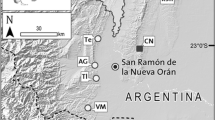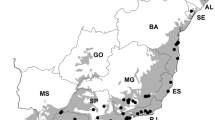Abstract
Dispersal-assembly theories of species coexistence posit that environmental factors play no role in explaining community diversity and structure. Dispersal-assembly theories shed light on some aspects of community structure such as species-area and species-abundance relationships. However, species’ environmental associations also affect these measures of community structure. Measurements of species’ niche breadth and overlap address this influence. Using a new continuous measure of niche and a dispersal-assembly null model that maintains species’ niche breadth and aggregation, we tested two hypotheses assessing the effects of habitat heterogeneity on the ability of dispersal-assembly theories to explain community niche structure. We found that in both homogenous and heterogeneous environments dispersal-assembly theories cannot fully explain observed niche structure. The performance of the dispersal-assembly null models was particularly poor in heterogeneous environments. These results indicate that non-dispersal based mechanisms are in part responsible for observed community structure and measures of community structure which include species’ environmental associations should be used to test theories of species diversity.




Similar content being viewed by others
References
Bell G (2001) Ecology—neutral macroecology. Science 293:2413–2418.
Chave J, Muller-Landau HC, Levin SA (2002) Comparing classical community models: Theoretical consequences for patterns of diversity. Am Nat 159:1–23
Clark DB, Clark DA, Read JM (1998) Edaphic variation and the mesoscale distribution of tree species in a neotropical rain forest. J Ecol 86:101–112
Condit R (1998) Tropical forest census plots: methods and results from Barro Colorado Island, Panama and a comparison with other plots. Springer, Berlin
Cressie N (1991) Statistics for spatial data. Wiley, New York
Davies SJ, Surpardi MNN, LaFrankie JV, Ashton PS (2003) The trees of Pasoh Forest: Stand structure and floristic composition of the 50-hectare forest research plot. In: Okuda T, Manokaran N, Thomas SC, Ashton PS (eds) Pasoh: ecology and natural history of a Southeast Asian lowland tropical rain forest. Springer, Berlin Heidelberg New York, pp 35–50
Davies SJ, Tan S, LaFrankie JV, Potts MD (2004) Soil-related floristic variation in the hyperdiverse dipterocarp forest in Lambir Hills, Sarawak. In: Roubik D (ed) Ecology of the Lambir Forest, Sarawak, Malaysia (in press)
Daws MI, Mullins CE, Burslem DFRP, Paton SR, Dalling JW (2002) Topographic position affects the water regime in a semideciduous tropical forest in Panama. Plant Soil 238:79–90
Denslow JS (1987) Tropical rainforest gaps and tree species diversity. Annu Rev Ecol Syst 18:431–451
Diggle P (1983) Statistical analysis of spatial point patterns. Academic Press, London
Feinsinger P, Spears EE, Poole RW (1981) A simple measure of niche breadth. Ecology 62:27–32
Gotelli NJ, Graves GR (1996) Null models in ecology. Smithsonian, Washington
Harms KE, Condit R, Hubbell SP, Foster RB (2001) Habitat associations of trees and shrubs in a 50-ha neotropical forest plot. J Ecol 89:947–959
Hubbell SP (1997) A unified theory of biogeography and relative species abundance and its application to tropical rain forests and coral reefs. Coral Reefs 16:S9–S21
Hubbell SP (2001) The unified neutral theory of biodiversity and biogeography. Princeton University Press, Princeton, N.J.
Hubbell SP, Foster RB (1986) Biology, chance and history and the structure of tropical rain forest tree communities. In: Diamond J, Case TJ (eds) Community ecology. Harper and Row, New York, pp 314–329
Kochummen KM, LaFrankie JV, Manokaran N (1990) Floristic composition of Pasoh Forest reserve, a lowland rain forest in peninsular Malaysia. J Trop For Sci 3:1–13
Kohyama T (1994) Size-structure-based models of forest dynamics to interpret population-level and community-level mechanisms. J Plant Res 107:107–116
Lee HS, Davies SJ, LaFrankie JV, Tan S, Yamakura T, Itoh A, Ashton PS (2002) Floristic and structural diversity of mixed dipterocarp forest in Lambir Hills National Park, Sarawak, Malaysia. J Trop For Sci 14:379–400
Legendre P, Legendre L (1998) Numerical ecology, 2nd English edn. Elsevier, Amsterdam
Levins R (1968) Evolution in changing environments; some theoretical explorations. Princeton University Press, Princeton, N.J.
Lieberman M, Lieberman D, Hartshorn GS, Peralta R (1985) Small-scale altitudinal variation in low-land wet tropical forest vegetation. J Ecol 73:505–516
MacArthur RH, Levins R (1967) The limiting similarity, convergence and divergence of coexisting species. Am Nat 101:377–385
Manly BFJ, Patterson GB (1984) The use of Weibull curves to measure niche overlap, N Z J Zool 11:337–342
Manokaran N, LaFrankie JV (1990) Stand structure of Pasoh Forest Reserve, a lowland rain forest in peninsular Malaysia. J Trop For Sci 3:14–24
Manokaran N, LaFrankie JV, Kochummen KM, Quah ES, Klahn JE, Ashton PS, Hubbell SP (1999) The Pasoh 50-ha forest dynamics plot: 1999 CD-ROM Version. Forest Research Institute Malaysia, Kepong
McKane RB, Johnson LC, Shaver GR, Nadelhoffer KJ, Rastetter EB, Fry B, Giblin AE, Kielland K, Kwiatkowski BL, Laundre JA, Murray G (2002) Resource-based niches provide a basis for plant species diversity and dominance in arctic tundra. Nature 415:68–71
Pianka ER (1973) The structure of lizard communities. Annu Rev Ecol Syst 4:53–74
Plotkin JB, Potts MD, Leslie N, Manokaran N, LaFrankie J, Ashton PS (2000) Species-area curves, spatial aggregation, and habitat specialization in tropical forests. J Theor Biol 207:81–99
Silvertown J, Dodd ME, Gowing DJG, Mountford JO (1999) Hydrologically defined niches reveal a basis for species richness in plant communities. Nature:400:61–63
Silvertown J, Dodd M, Gowing D (2001) Phylogeny and the niche structure of meadow plant communities. J Ecol 89:428–435
Terborgh J, Foster RB, Nunez PV (1996) Tropical tree communities: A test of the non-equilibrium hypothesis. Ecology 77:561–567
Tilman D (1982) Resource competition and community structure. Princeton University Press, Princeton, N.J.
Whitfield J (2002) Ecology: neutrality versus the niche. Nature 417:480–481
Acknowledgements
M.D.P. was supported by an NSF Bioinformatics Post-Doctoral Fellowship, DBI-0204070 and 1-year post-doctoral research fellowship provided by the Center for International Development, John F. Kennedy School of Government, Harvard University. The research was supported by NSF grant DEB-0075334. We would like to thank Peter Ashton who provided comments on early drafts of the paper.
Author information
Authors and Affiliations
Corresponding author
Rights and permissions
About this article
Cite this article
Potts, M.D., Davies, S.J., Bossert, W.H. et al. Habitat heterogeneity and niche structure of trees in two tropical rain forests. Oecologia 139, 446–453 (2004). https://doi.org/10.1007/s00442-004-1525-3
Received:
Accepted:
Published:
Issue Date:
DOI: https://doi.org/10.1007/s00442-004-1525-3




